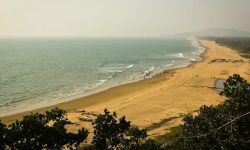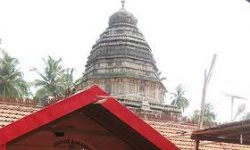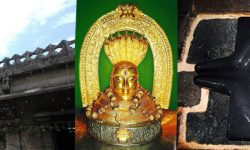Tag: mahabharat
9) AGNI PURANA – Hari Vamsa Puranam in English

Hari Vamsa Puranam in English As you have already been told, Brahma emerged from Vishnu’s navel. Brahma’s son was Atri, Atri’s son Soma, Soma’s son Pururava, Pururavas son Ayu, Ayu’s son Nahusha and Nahushja’s son Yayati. Yayati had two wives, Devayani and Sharmistha. Devayani had two sons, Yadu and Turvasu….
58) THE DECLINE OF YADU DYNASTY
Parvati was listening to the divine tales of Sri Krishna with rapt attention. Lord Mahadeva told Parvati– ‘Paundrak was the king of Kashi. He did an austere penance for twelve years to please me. When I appeared before him, he requested me to make his appearance look like Sri Krishna….
BHAGAVAD GITA SUMMARY, BHAGAVADGITA – A scripture
The Bhagavad Gita (Song of the Lord) is one of the most loved scriptures of India. It is pan-Indian, even though its central character, Arjuna, discovered that the driver of his war chariot, Krishna, was the supreme lord of the universe, Lord Vishnu. If this claim were taken literally and…
ARJUNA, Arjuna Story in English – A hero and warrior
AGNI -A deva (god), god of fire, Agni puran
ADITI -A devi (goddess), Mother of The Gods, Aditi devi story

There are few interesting myths to tell about Aditi, but her status and roles change so remarkably that she illustrates the fluidity of Hindu myths. Her name literally means eternity (free, boundless, infinity), so philosophically she is a personification of time. Aditi slowly evolved as the prototype of…
A FEW VERSES REFERRING 10 GOKARNA, FOUND ON OIFFERENTS PURANAS
Tataha Krodhena Tenaiva Dahagreevaha Sahanujaha| Agachchadatma Midhyartham Gokamasya Shramam Shubham || Valmeekeeye U. Cam 9 Sa. 46,47) Tatahaivabdherastate Lingam Gokama Ravanatvaya | Graheetva sthapitam Poorvam Ravanopi Graham Yayow || 142, 43 || Drastavai Dhanadhyaksham Pushpakshatam Tu Kaikasee | Putran Dhikkarayamasa Yooyam Sandhya Mratopamaha ||46|| Te Matmvachanam Shrutva Yayu Gokamayuttamam ||45|| (Anandarama…
SHRI KSHETRA GOKARNA MAHABALESHWAR – JOY & BEAUTY OF GOKARN

Now a few words about the historic antiquity of Gokarn. As already refered to and quoted about, there are free and frequent mention of Gokarn Kshetra in the major epics and Puranas such as Ramayana, Mahabharata, Bhagavata, Skanda Purana and many other theological scriptures. Kalidasa mentions the Lord of Gokarn…
SHRI KSHETRA GOKARNA MAHABALESHWAR – NAGESHWAR
Shri kshetra gokarna mahabaleshwar – A Unique immortalism of Gokarn
4) CHAPTER FOUR DESCRIPTION OF SURYAVANSH
King Sagar had two queens, Sumati, the daughter of Kashyapa and Keshini, the daughter of Vidarbha’s king. Keshini had a son Asmanjas whereas Sumati had sixty thousand sons. Anshuman was the son of Asmanjas. Asmanjas was very whimsical since his childhood. Even in his youth, he did not change his…
22) Krishna’s Tapasya
Krishna was the eight incarnation of Vishnu and he was born as the son of Devaki and Vasudeva. Initially, Krishna did not have any sons. Desirous of obtaining a son, Krishna went to visit the sage Upamanyu. The sage’s hermitage was beautiful. Wonderous were the trees and flowers and grew…
12) Daksha’s Story
Daksha was Brahma’s son and had a daughter named Sati. Sati was married to Shiva. Daksha was thus Shiva’s father-in-law. Once Daksha came to visit his son-in-law. But although Shiva worshipped him with all due respect, Daksha felt that he had been slighted. Subsequently, when Sati went to visit…
11) The Line of Uttanapada
It is hoped that you have not forgotten that Svayambhuva Manu and his wife Shatarupa had a son named Uttanapada. Uttanapada’s brother was Priyavarta. Dhruva was Uttanapada’s son. Dhruva was so devoted to Vishnu that Vishnu earmarked for him a place in the heaven known as Dhruvaloka. (Dhruva became the…
1) KURMA PURANA
(The samudra manthana story is given in great detail in the Ramayana and the Mahabharataa. As for Lakshmi, some of the Puranas state that she was born as the daughter of Khyati and the sage Bhrigu. She was then married to Vishnu. But the demons defeated the gods and Indra….
2) CHAPTER TWO DESCRIPTION OF KURU VANSH
The lineage of Puru grew as Puru, Janmejaya, Prachinvan, Praveer, Manasyu, Abhayad, Sudayu, Bahugat, Sanyati, Ahamyati, Raudrashva. Raudrashva had ten sons among whom Riteshu was the most prominent. Riteshu had three sons among whom Apratirath was most prominent. Lineage of Apratirath is as follows- Apratirath, Aileen, Dushyant and Bharata. King…
10) BRAHMA PURANA – Sagara
Trishanku’s son was Harishchandra and from Harishchandra was descended a king named Bahu. Bahu devoted too much time to pleasurable pursuits. The upshot of this was that the defence of the kingdom was not properly taken care of. Enemy kings seized this opportunity to attack Bahu’s kingdom. They drove Bahu…
VYASA, Vyasa Maharshi, Veda Vyasa Story- The most famous sage in Hindu mythology
TILOTTAMA – An apsara
TIRTHA-YATRA – A practice
A yatra was a pilgrimage, or visit, to a river crossing, or ford (tirtha). Thus the term tirtha-yatra came into usage. Over the centuries it came to mean a visit to any holy place, a pilgrimage to a sacred region (such as the plain where the Mahabharata battle was fought),…
DATTATREYA PREACHES ALARKA
Alarka says- ‘O lord! With the arising of disenchantment in my heart, I have no miseries now. Only those people feel drowned in the ocean of miseries who are attached to worldly things. A man feels all kinds of sorrows due to his attachments towards the luxuries in which his…
SURYA, Surya Dev Mantra in English – The sun god
SISUPALA, Shishupal and Rukmini, Shishupal Brother
Sisupala was the third rebirth of Jaya for his failure to carry out his duty (dharma) as a doorkeeper (dwarapalaka) of Lord Vishnu at Vaikuntha. He was cursed because of that failure, and he played a role in three incarnations of Vishnu. His twin brother Vijaya shared in the original…
SARASWATI Mata mantra, Saraswati wife of Brahma- A goddess

Sarasvati is a goddess of primary importance. She is accepted by Hindus as the goddess of learning, the arts, and scholarship. However, Sarasvati’s nature is far more complex and her mythology more interesting than is widely known. Sarasvati, whose name means “flowing” and “watery,” has been associated with an ancient…
SAPTA-MATRIS, SAPTA-MATRIKAS – Seven mothers

The collective name of the seven divine mothers—seven (saptan) mothers (matris or matrikas)—has been associated with Siva both in mythology and iconography. The Brahmanical view in the Mahabharata depicted them as destructive female energies responsible for ill fortune and disease and especially attracted to harming children. The mothers were assimilated…
RITA – A concept
Rita was a concept in the Rigveda that was associated with cosmic order, as well as truth and justice. Rita can be said to be a Vedic version of the later concept of dharma. Linguists point out rita’s kinship to the Avestan word asha and Varuna’s place in ancient Persian…
Tale of Lord Krishna’s life in Bhagavata Purana
Hearing the tales of Royal dynasties from Sukhdev, king Parikshit requested “Guruvar, you have just narrated the surprising tale of Suryavanshi and Chandravanshi (dynasties). Now I wish to hear the tales of Lord Krishna’s life in detail. It was because of God’s grace that my ancestors could successfully win the…
CHANDRA DYNASTY
Sukhdev says, “Parikshit, now I narrate about Chandra dynasty. Many great and pious kings like Pururava had occurred in this dynasty. Chandrama was the son of Atri, the son of Brahma. Budh was the son of Chandrama while Pururava was the son of Budh. Ila was the mother of Pururava….
EXPIATION OF BALARAMA
Sri Krishna’s brother Balarama had remained impartial in the battle of Mahabharata. Instead of championing the cause either for the Pandavas or for the Kauravas, he had preferred to go on a pilgrimage. His wife Revati also accompanied him on this pilgrimage. Once while travelling, Balarama drank toddy and entered…
DIVINE PLAYS OF GOD
Sage Jaimini reached Vindhyachal and arrived before the birds as per Markandeya’s instructions. He said- ‘O birds! I am Jaimini, the disciple of Veda Vyasa. I have come here with a desire to have your glimpse.’ The birds welcomed him saying- ‘It is our great fortune that you have arrived…
BIRDS MIGRATE TO VINDHYACHAL
Sage Shami thereafter began to foster the chicks in his hermitage. With time, the chicks grew feathers and began to fly here and there. But every time the birds went out, they returned to the hermitage by evening. The birds also gained Vedic knowledge by hearing the discourses, which sage…
VARIOUS CREATIONS AND FAMOUS MYTHOLOGICAL CHARACTERS BIRTH OF FOUR BIRDS
Markandeya says – ‘In the lineage of the avian King Garuda, there were two brothers- Kank and Kandhar. One day, Kank visited Kailash Parbat where a demon Vidrayudrup, who was a slave of Kubera, was enjoying privacy with his wife and drinking wine. Seeing Kank, the demon showed his displeasure…
MARKANDEYA PURANA
Once Jaimini, a disciple of sage Veda Vyasa expressed his curiosity before Markandeya- ‘O Lord! In the great epic Mahabharata, which was created by Veda Vyasa, description of Dharma, Arth, Kama and Moksha appears to be intertwined at times and at other times, it appears to be separate from one…
RAMAYANA Story- An Epic
PARIKSHIT – A king
NARAKA, NARAKASURA – An asura (demon)
Hiranyaksha in the form of a boar had abducted the earth, Bhumi, and taken her to Patala, one of the netherworlds. On the way his tusks touched Bhumi, and she became pregnant with Naraka. Vishnu came in the form of a boar, Varaha, and killed Hiranyaksha. Vishnu rescued Bhumi and…
NARA – A sage
NAKULA – The fourth of the Pandava brothers of Mahabharata fame
NAHUSHA – A king
MARICI – A Marut; a Prajapati; a maharishi
MAHAMERU – Great Meru, a celestial mountain
MAHABHARATA – One of the two Epics; a scripture
KURUKSHETRA – A place north of modern Delhi

Kurukshetra simply means “the field of the Kurus.” The Kurus or Kauravas decended from Kuru, a king of the Lunar Dynasty. About eighty-five miles north-northeast of Delhi, Kurukshetra has been an important pilgrimage site (tirtha) for at least twenty centuries. References in the Mahabharata to a firealtar (vedi) of Brahma…
KUNTI – Mother of the Pandavas and wife of King Pandu
KUBERA – A dark spirit who became the wealthiest god (deva)
Kubera has been interpreted to be a deva and, as such, the god of wealth. There were several versions of his parentage. In the Atharvaveda Kubera was chief of the spirits of darkness and son of Vaishravana. In the Mahabharata Kubera was son of the grandfather (prajapati) Pulastya, by his…
KRISHNA – Ninth incarnation of Vishnu; the Absolute itself
The Krishna myth cycle has been integrated in such a way that most Hindus do not know its real complexity. Some of its elements are very ancient, showing that many myths have come together to form modern versions. First, there was the Krishna myth of a divine king, possibly…
KASYAPA – A prajapati (progenitor) who fathered all beings; a sage

Kasiyapa-Prajapati has a major role in creation. However, there were variations concerning his birth and his status. In the Mahabharata Kasiyapa was only the son of Marici, who was one of the six mind-born sons (manasa-putras) of Brahma. The Valmiki Ramayana added Kasiyapa as the seventh and youngest sons…



















